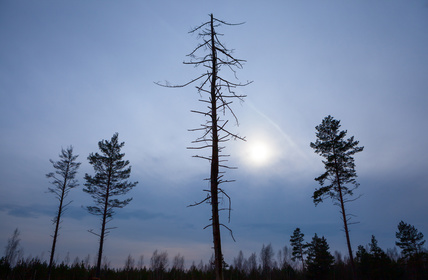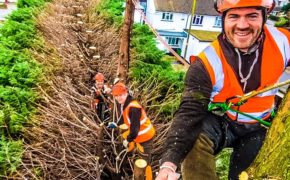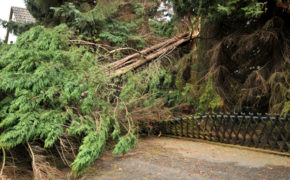
Get a quick no obligation quote It’s free and will only take a jiffy!
How do I Check if my Tree is Dead or Dying?
A dead or dying tree can pose a serious safety hazard. There is the very real risk of, at very least, branches falling unexpectedly, or at worst, the entire tree falling, especially if there has been a storm or high winds.
But how can you tell if a tree is dead or dying? And what should you do about it?
What are the Signs of a Dead or Dying Tree?
Symptoms of a dead or dying tree vary depending on the species of the tree. One definite sign however is a thinning canopy outside of autumn. This could be across the entire tree, or just in one isolated part.
Falling bark is another sign, as is a trunk that feels spongy or brittle to the touch.
Whilst dead wood in a tree is a natural part of the growth cycle and can result in falling branches, this could also be a sign of a diseased tree. Any symptoms like these should be immediately investigated by a qualified arborist.
In some cases, a diseased tree can be saved, and the earlier the issue is identified, the more chance there is of the damage being overcome.
What are Some of the Most Common Tree Diseases and Their Symptoms?
Acute Oak Decline (AOD) has affected thousands of oak trees, mainly across Southern England, East Anglia and the Midlands since the 1980s. Affecting both native oak species of Great Britain (Pedunculate Oak and Sessile Oak), as well as some other species, AOD symptoms include dark fluid bleeding from cracks in the bark, fast decline of the tree and ultimately, death of the tree which usually happens within four or five years of the onset of symptoms. There are usually also D-shaped holes where the oak jewel beetle has exited the bark. AOD sightings are required to be reported to the Forestry Commission using their Tree Alert programme.
Chalara or Ash Dieback affects ash trees. It is caused by a fungus and symptoms include dieback of the tree’s crown, loss of leaves and lesions on the bark. There is usually no way back for a tree once it has the disease: if it doesn’t succumb to the disease itself, the weakened tree will be prone to fungi or pests. If the disease is spotted, it should be verified before being reported using Tree Alert.
One of the most well-known tree diseases, Dutch Elm was first detected in 1910. By the 1940s it had caused losses of up to 40 per cent of elms across Europe. A further, much more devastating epidemic occurred in the late 1960s and was caused by an aggressive fungus. Within ten years some 20 million elms out of around 30 million in the UK were dead, and by the 1990s this had grown to more than 25 million.
Symptoms appear in early summer and include clusters of yellowing or wilting leaves which turn brown and then fall. Shoots affected by the disease die back from the tip. Because it is a progressive disease, an affected tree can appear to be healthy in places, and in others bear yellow or brown foliage. A tree surgeon will confirm the disease is present by peeling the bark back and looking for dark brown or purple streaks. There is no need to report any instances of Dutch Elm disease.
Why do Trees Die?
Most trees lead long lives, often surviving through decades and sometimes centuries. However, they can be affected by certain factors such as the local environment, disease, fungus and insects, and sometimes it’s just a case of old age.
A tree’s lifespan is dictated by its species and its size. Smaller trees tend to have a lifespan of around 20 years, whereas larger trees will reach 75 to 100 years of age. Pine and oak trees are even hardier and will typically enjoy a long life of two to three centuries, depending on environmental factors.
What to do About a Dying Tree?
If a tree is dying of old age, sadly there is nothing that can be done to save it. You will need to engage a tree surgeon to come and safely take the tree down so that it doesn’t fall unexpectedly and cause damage to property, or injure someone. They will confirm before doing so that the tree has come to the end of its life, so that you can be sure you are doing the right thing.
Can Sick Trees be Saved?
If a tree is diseased, sometimes it can be treated, although it very much depends on the stage and type of the disease. A good tree surgeon will be able to advise you as to whether a tree can be saved, and will commence appropriate treatment if you are agreeable on the fee.
What to do if a Tree with a Preservation Order is Dead or Dying?
If there is an immediate risk of serious harm, the government guidelines state that five working days’ notice must be given to the local authority before working on or cutting down a dead tree that is subject to the Tree Preservation Order. No consent is required, but the notice is mandatory. Dead branches can be removed from a living tree without notice or consent, however it is important to consider plants and wildlife that may have made the branches their home, and which may also be protected under government legislation. You can read the guidelines in full here.
Expert Assistance from T.H. Tree Services
If you have reason to believe that a tree on your land is dead or dying, do not hesitate in calling in expert assistance, as it could well prove hazardous, not to mention you may be in time to save the tree with the right help.
T.H. Tree Services are fully qualified tree surgeons with over a decade of experience in dealing with dead or dying trees and their treatment or removal. To find out more and for a competitive quote, call 01268 642 814.
Had a fallen tree in the early hours of Monday morning, called for quote and the team had it cleared on the same day. Really good communication when the lads were onsite and did a great job. Lots of pride in their work shown with the thorough clear up. Would thoroughly recommend.
Thank you Stuart for your kind review. We were glad to be able to help you with your fallen tree. If there's anything else you need in the future, please don't hesitate to get in touch.








